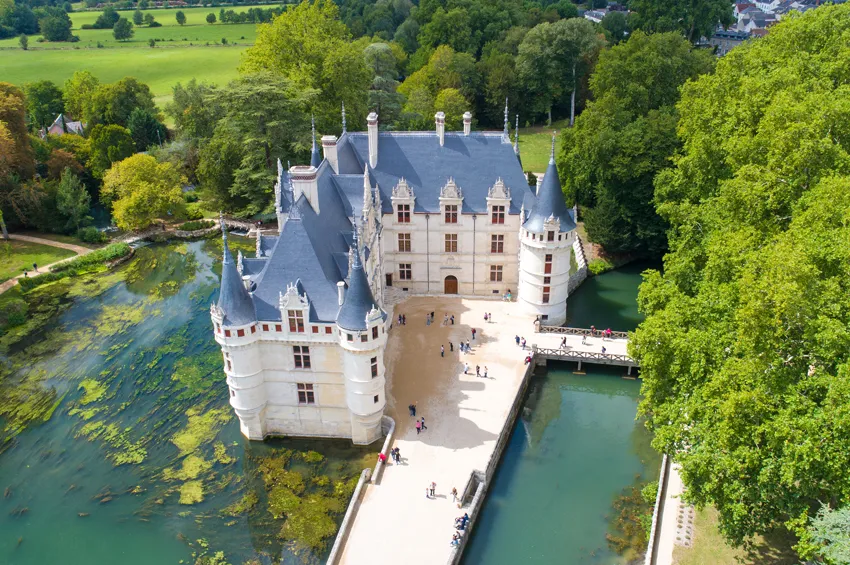
The beauty of the landscapes of the Loire are legendary. Here and there a castle, a fortress or an abbey and, in the distance, the forest bordering the picture.
The Loire particularly inspired the famous English water-colourist William Turner called the "painter of light". Joachim Du Bellay, a French poet of local descent, praised the Angevin sweetness.
After him, Jean de la Fontaine, Beaudelaire, Victor Hugo, and many other romantic souls dipped their pen in the vaporous atmosphere of the Loire Valley which became, in the Renaissance, the place of residence of the Kings of France. Their castles, veritable jewels encrusted in dream scenery, enjoy an international reputation. Chambord, Villandry, Azay-le-Rideau, Amboise, Ussé ... The "Royal River” – The Loire.


The Loire Valley tells the story of a unique river. The only river in Western Europe that has never been canalised, which is why it is called "the last wild river in Europe". It follows its course over 1,006 km, as majestic, intractable, subject to floods, sandbanks that make its draft variable, from Mount Gerbier-de-Jonc in the Ardèche, to the Atlantic Ocean.
Navigable over 700 km until the eighteenth century, the Loire is today officially, only navigable between its mouth at Saint-Nazaire to Bouchemaine near Angers.
It is this river, free in a way, that has shaped the enchanting scenery of the Loire Valley.
The Loire Valley was beautifully nicknamed "Garden of France" by the nobles of the fifteenth and sixteenth centuries. It is full of orchards, gardens and vineyards that produce wines of great diversity. From Sancerre, Touraine, Anjou, Saumur ... They accompany a refined gastronomy which gives pride of place to its fish caught in abundance and the meats coming from the regional agriculture, without forgetting the cheeses.
Rabelais, child of " the country”, father of Gargantua and Pantagruel, must have feasted, literally and figuratively, on these favourite lands of aristocrats as mariners, farmers, and simple townspeople.
Until the nineteenth century the Loire remained the most important means of communication for the transit of goods. The opening of the Briare canal in 1642 and of Orléans in 1692 brought the Loire and Seine together.
From the heights of Saint-Rambert, 80 kms of road barely separated it from the Rhone which opened the way to the Mediterranean.
The Loire Valley also experienced a cultural explosion that began at XVI th century. Printing took off directly from intellectual emulation. It was in Angers where the colossal fortress of King René was erected, that the first printing company opened in 1477.
Finally, the kings, Charles VIII, Louis XII and Francis I, who discovered Italy, launched the great French Renaissance.
It is the nobility who launched here "the art of living the French way". The Loire Valley was inscribed in 2000 as a UNESCO World Heritage Site under the heading of Living Cultural Landscapes. The Loire Valley is remarkable for its monumental heritage of international renown and for the quality of its urban sites.
This landscape testifies to harmonious development between man and his environment for over two thousand years of history.


The Loire, cradle of river navigation, also tells the story of the marine industry with Saint-Nazaire as its figurehead. At the "terminus" of the Loire, just after Nantes, one of the largest shipyards in Europe perpetuates a world-renowned know-how.
It is the pride of a long line of sailors who have the memory of beautiful days of navigation pegged to the heart.
Until the nineteenth century, thousands of sailing boats were used to transport passengers and various goods.
But the arrival of the extended railway from Orleans to Tours in 1846 and six years later to Nantes, plunged more than 6000 sailors into the mourning as the Loire marine was sacrificed on the altar of modernity and the rapidity. The last steamboats with their characteristic profile disappeared from the landscape at the dawn of the twentieth century.
Remained however is the timeless spectacle of the boatmen who always circulate aboard , barges and “futreaux”: flat-bottomed boats used uniquely on the Loire and formerly utilitarian which formed an integral part of the fluvial inheritance.
And now, 100 years after the last steamboats, in 2015, a new cabin tourism ship discovers this exceptional environment, respectful to these capricious waters.
A new generation paddle steamer, the MS Loire Princesse, model of modern technology, unique in the world, pays tribute to the naval industry engraved in the history of the Loire. A renaissance, in a way, of the high-level sailing tradition for tourists enamoured by the beauty and French “art de vivre” way of living. An idea engaged by CroisiEurope.